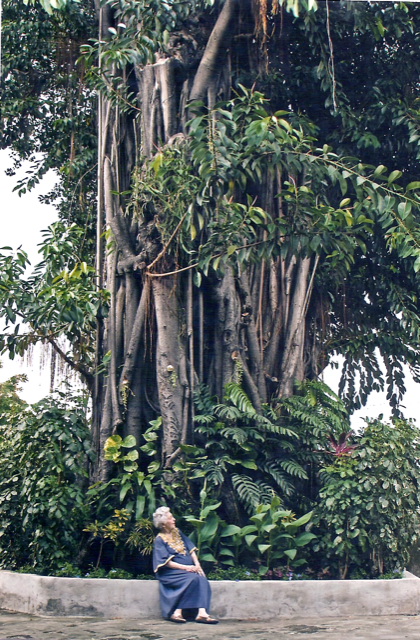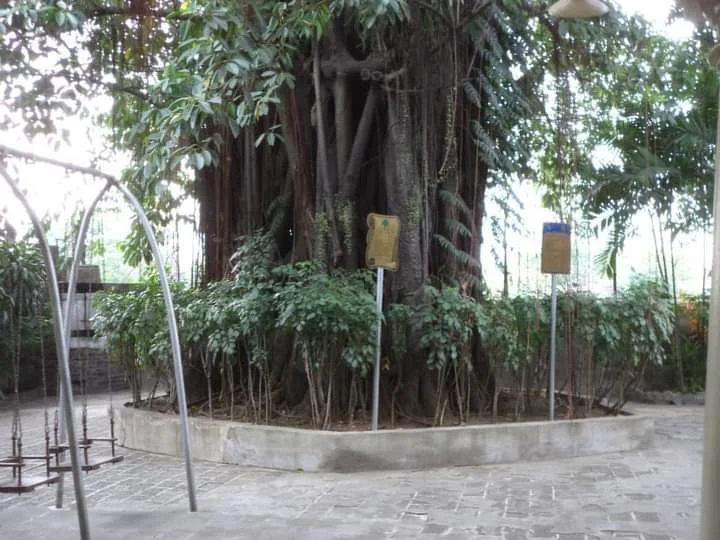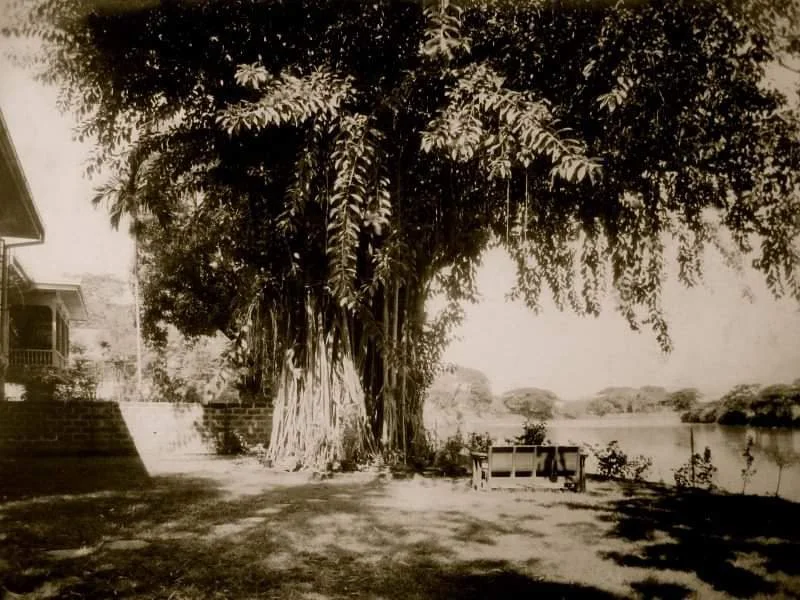Our Rubber Tree Becomes a Heritage Tree
/The family matriarch Jessie Lichauco and the Heritage Tree
It stood between our house and the Pasig, shielding us from the hot tropical sun, and muffling the incessant growl of tugboats groaning upstream drawing massive barges that threatened to careen into our dike with every passing wave.
The tree was constantly in our lives. Sometimes it was a benevolent presence, by the day we played under its enormous canopy, racing around and around it on our bikes, or just relaxing in its cool shade. Other times it was a brooding presence, its branches waving menacingly as typhoon signal number five sounded in the distance, and its leaves urgently whispering “stay home!”
We called it a rubber tree. I don’t really know what kind of tree it is. Sometimes I hear it called a banyan tree or a Balete tree. I’ve even heard “strangler fig” on occasion. But “rubber tree” fits glistening gobs of sticky sap that ooze out of the trunk. You could roll these into balls that bounced, though never straight. But hurling these against the dike wall and trying to catch them on the first bounce made us all better infielders.
Unlike most trees, which have trunks that grow up, this one had trunks that grew down. They started out high up in some branch, deep in the foliage as a bundle of vines. Then they’d get longer and fatter. By the time you could reach them, they were easily strong enough to swing on. And swing we did. Sometimes, when no one was looking, out over the river. Eventually, the vines would reach the ground, take root in the soil and gradually cloth themselves in bark.
A tree like this doesn’t make a good neighbor for a house. It was a never-ending job cutting the vines before they could take root. Eventually, someone decided to throw in the towel and just pave the back yard. Nothing could grow in the shade of that tree anyway.
But it was more than a tree to us seven children. It was a forest in itself. The vines from its tall branches would take root and expand into more tree trunks. It was very dense and though we could not get deep inside, we knew reptiles and birds called it home – bayawak (monitor lizard), tuko (gecko), snakes, a myriad of birds, even a monkey-eating eagle which we saw close-up.
The tree was the backdrop for getting our heads shaved so we would develop thick curly hair. Over the low riverside wall we could spot all sizes of boats, from dance boats to mighty tugboats hauling over a dozen barges and we could wave until they were around the bend and out of sight. Then in a tricycle and scooter convoy we sped around the tree, as cowboys on horseback or “Indianapolis 500” racers, holding our breath as we squeezed by the narrow space by the stone wall which separated our property from the Pasig River. Under the tree our parents built us a small playhouse, but we were out of it, more than in it.
On one side, the tree had roots extending to the other side of the river, where a match factory hummed in the distance. On another side, its roots went under our house, under the main street, reaching a girls convent school across Herran Street (now Pedro Gil). Only with such deep and extensive roots, well-watered by the Pasig River could our tree dare climb so high and extend its branches so far, shielding our home from the tropical sun.
Even at night we felt the tree’s presence. Our children’s bedroom was on the second floor with full screen windows looking out over the back of the house. The tree cast its protective covering over us. Through it, we could see the moonlight reflecting on the river, only now we were more aware of the creatures living among its roots and branches. We children would fall asleep to the sound of geckos repeating tu’ko..tu’ko..tu’ ko…
We have always loved our old house with the dark wooden walls and floors, our beautiful tree and the refreshing river that runs along beside it. These three seem to be one, so long have they existed beside each other -- the river giving nourishment and life to the tree for perhaps two centuries, the tree in turn protecting, shading and sheltering our house and the families living and growing there.
In 2012, during World Environmental Month, the tree became the center of attention at the festive unveiling celebration with the then-Department of Environment and Natural Resources Secretary Ramon Paje and then-Manila Mayor Alfredo Lim. Unveiling twin markers, Secretary Paje declared the Balete a Heritage Tree now protected and commemorated for its aesthetic, historical, cultural, social and educational significance. It is the second tree with this distinction in Metro Manila, the first tree on private property.
Left to right: Ernie Panis, DENR Asec. / DENR Secretary Ramon Paje / Jessie Lichauco/ Sylvia Lichauco de Leon/ Manila Mayor Alfredo Lim/ Hilarion Henares,Jr./. Marcial Lichauco Jr., Gemma Cruz-Araneta
The Heritage Tree with two markers from the Department of Environment and Natural Resources
The Banyan Tree Marker
Mayor Lim, awed at the enormous girth and height of the Majestic Balete, said, “If this tree could talk, it would tell us about this oldest settlement on the Pasig in Manila; it would tell us how the Pasig looked a century ago, as it counted the boats that passed on their way to Laguna de Bay… The tree has survived in an urban area because it is fed by the Pasig River,” he said, “but more significantly it was showered and pampered by the tender loving care of the Lichauco family”.
Secretary Paje spoke of the many thousands of trees that DENR had planted. “This ancient magnificent tree alone is worth more than all those put together because it is located on private land,” he noted. He congratulated our mother Jessie for her altruistic and generous endeavor in conserving the house, a declared Heritage House, and the tree for future generations to appreciate.
The Lichauco house, one of the remaining large riverside houses from the Spanish era when Santa Ana was the Forbes Park of the times, was declared a Heritage House by the National Historical Commission of the Philippines. During the liberation of Manila in1945, Santa Ana was a haven for thousands of injured and homeless survivors because it was the only area left unscathed. Our father, Marcial, and mother, Jessie, ministered to hundreds of survivors in the nearby family house. Immediately after the war they moved into this house with the Balete tree.
The tree many many years ago... pre WWII
We are so pleased that our mother, who in January 2012 celebrated her 100th birthday, can continue her senior years enjoying her heritage house in a heritage district cooled by the shady heritage tree, telling her amazing stories of life in the years gone by - feeling like a true heritage woman. [Note: Jessie Lichauco passed away in 2021, at 109 years old.]
If you pass our house by boat along this, our River Pasig, you can see the whole tree from another angle - a different view with more of its external entirety. If you pass by it quickly as the vessel rounds the bend, too soon after, you catch sight of its magnificence. Even from there you may note its informality, its hospitality, its protectiveness. You may see in those moments, children standing, moving and waving to you from atop the dike walls as your boat speeds long, with big waves lapping behind.
Loretta Lichauco-Baquiran was active in the arts and culture education field in the Philippines for years prior to and during martial law. She also taught at Assumption, De La Salle, the University of the Philippines and Ateneo de Cagayan. Loretta wrote book reviews and articles for the Manila Chronicle and the Kinaadman Journal in Mindanao.
After living in the US for 40 years, Sylvia Lichauco-de Leon returned to Manila to work on migrant workers human rights as a co-convenor of the International Conference on Gender, Migration and Development, with the Philippine government and UN agencies. This experience firmly rooted her back in the Philippines and led to many other advocacies which she pursued relentlessly, among them fighting to preserve the cultural heritage of historic Santa Ana.







